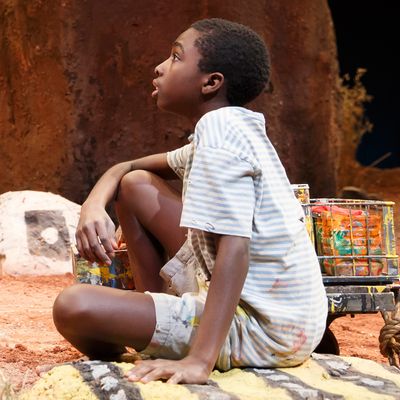
On a farm in South Africa, a large boulder stares down a local painter like a blank canvas. The painter — someone we would categorize today as an outsider artist — is Nukain Mabusa, an old black worker who has for years been turning an outcropping of rocks on the land of his Afrikaner boss into what he calls a garden of flowers. (They are very abstract flowers, more like woven patterns than anything botanical.) By 1981, when the first act of Athol Fugard’s The Painted Rocks at Revolver Creek takes place, Mabusa’s life’s work is almost done, with the exception of The Big One: that large, forbidding boulder. Despite encouragement from Bokkie, the 11-year-old boy who serves as his assistant, dragging a little wagon of paints and brushes behind him, Mabusa cannot face it, perhaps (he eventually realizes) because it has no face. The action only really begins when he understands that The Big One is not meant to be a final flower among his hundreds but instead the story of his own life: an expression, before death, and regardless of the conditions that limited and degraded him as a black man in apartheid South Africa, of the fact that he lived. (The play is suggested by the real Mabusa’s life and work, but is otherwise explicitly fictional.) Watching him (and Bokkie) erupt with creative passion, covering the rock face with a human face in bursts of orange, yellow, red, green, blue, black, and white, I was reminded of a similar (if less polychromatic) moment in the John Logan’s Red, when Mark Rothko, also with the help of an assistant, suddenly channeled a life’s worth of conflict into a thrilling moment of abstract portraiture.
Unfortunately, the painting of The Big One is the highlight of the Fugard play, which in Act Two jumps 22 years into the post-apartheid future to see what has grown from the politics so carefully planted beneath the aesthetics of Act One. Mabusa is dead; Bokkie, now an adult named Jonathan Sejake, has returned to the farm to see if he can restore the neglected artworks, which would not become famous in real life until several years later. Sejake is stymied in this pursuit by a figure from his past: Elmarie Kleynhans, the wife of the Afrikaner farmer who still owns the land and who once patronized Mabusa in both senses of the word. In 1981, though she also paid for his paints, she blithely ordered the artist to erase his spiritual self-portrait, which she found menacing, and to whip young Bokkie for his cheekiness in defending it. Now, in 2003, the only power Kleynhans has over Sejake is the power of the gun she aims at him. (He’s trespassing.) The shifting political landscape has not softened her attitudes but rather hardened them into something that looks like psychopathology. Still, Sejake says they must try to understand each other. “If we can’t do that … then one thing is certain: Our future will be as big a mess as anything in our past.”
That the dialogue rarely rises much beyond this level is part of Fugard’s own aesthetic profile. (He fits his definition of an outsider artist — “someone who has created something significant or beautiful with no formal training in any artistic discipline” — by virtue of having dropped out of college in 1953 and having paved his way to the stage largely by starting theaters.) His faith in old tropes (don’t trip on all the symbols) and creaky dramaturgy (actions are recalled, then reenacted, then recalled again later, and re-reenacted) reminds you that what outsider art is outside of is the contemporary struggle to locate meaningful new modes of argument. Outsider art is essentially conservative (formally, not politically) and so a play like The Painted Rocks, meant no doubt to be as timeless as Mabusa’s flowers, seems timebound instead: as if it might have been written at the beginning of Fugard’s long career instead of near the end. (The Blood Knot, his first international success, premiered in 1961; let’s hope that Fugard is wrong when he suggests that, at 83, he may be offering in The Painted Rocks his “farewell to the stage.”) This is not to say that Fugard’s traditional works can’t be powerful, but their power is, to my mind, not always sufficiently theatrical, especially when they approach his great subject — the distortion of human relations on both sides by the apartheid state — as head-on as this one does. What argument can really proceed between a survivor who feels entitled to reparations and a perpetrator who sees herself as “a daughter of Job”? There is not much room for movement, dramatic or otherwise, in a world where whites cannot see the lives of their victims, even when those lives are painted in bright colors on giant boulders.
Thus the gun. And thus, less desperately, the excellent performances of the four-person cast, under Fugard’s obviously authentic direction. (A child actor named Caleb McLaughlin is extraordinary as Bokkie and makes a beautiful pairing with the magnetic Sahr Ngaujah as his older incarnation.) You need artists of this stature to succeed in the very unpromising environment of The Painted Rocks, whose dialogue sounds like notes toward an ideology rather then expressions of it. (It’s as if Mabusa decorated his boulders with scenes from life under apartheid instead of flowers.) We’ve seen this before with Fugard; when you’ve written 34 or so plays, most of them about one of the world’s most hateful and intransigent regimes, not all can be a Blood Knot or a “Master Harold” … and the Boys. Some, like The Painted Rocks, will be mute, if no less monumental.
The Painted Rocks at Revolver Creek is at the Signature Theatre through June 14.




